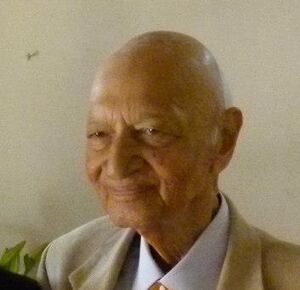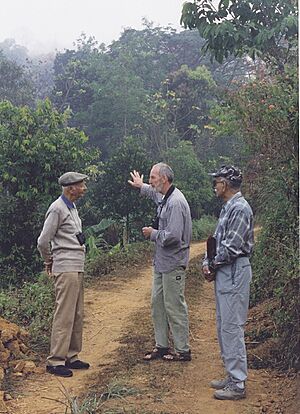Zafar Futehally facts for kids
Quick facts for kids
Zafar Futehally
|
|
|---|---|
 |
|
| Born | March 19, 1920 |
| Died | August 11, 2013 (aged 93) |
| Alma mater | St. Xavier's College, Mumbai |
| Spouse(s) | Laeeq Futehally |
| Children | 3, including Zai Whitaker |
| Relatives | Romulus Whitaker (son-in-law) |
| Family | Tyabji family |
| Awards | 1971 Padma Shri 1981 Order of the Golden Ark |
Zafar Rashid Futehally (born March 19, 1920 – died August 11, 2013) was a famous Indian naturalist and conservationist. A naturalist is someone who studies nature, and a conservationist works to protect it. He was well-known for his work as the secretary of the Bombay Natural History Society. He also started the Newsletter for Birdwatchers, a special magazine that helped people who watched birds all over India share what they saw.
Zafar Futehally received important awards for his work. The Government of India gave him the Padma Shri award in 1971. He also received the Dutch order of merit called the Order of the Golden Ark in 1981. In 1983, the Government of Karnataka honored him with the Karnataka Rajyotsava award.
Contents
Early Life and Education
Zafar Futehally was born in Andheri, India, in 1920. His family lived in a house called Gulshun. His father started a company that traded cotton and textiles with Japan. In 1924, his family moved to Japan for a few years to help with the company. They returned to India in 1927.
Zafar Futehally went to St. Xavier's College, Mumbai in Bombay. He studied economics and political science. He finished his studies in 1941.
Career and Family
After college, Zafar Futehally worked at his brother's company, Dynacraft Machine Company, starting in 1942. His grandfather was Badruddin Tyabji, a well-known lawyer. Zafar was also a distant cousin of the famous bird expert, Salim Ali.
Zafar married Laeeq Futehally on December 19, 1943. Laeeq was Salim Ali's niece. They had three children: a son named Murad, and two daughters named Zahida (Zai) and Shama. Both Zai and Shama became writers. Zai wrote books about Romulus Whitaker and Salim Ali. Shama, who passed away in 2004, wrote novels and translated poetry.
In 1972, Zafar and Laeeq moved to Bangalore. Laeeq was very good at gardening and wrote articles about it for a newspaper. After an incident at their home in 1987, they moved to Kodaikanal for four years. There, they worked with a group called the Palani Hills Conservation Council. Later, they returned to Bangalore. In 2013, Zafar moved back to his home in Kihim, where he passed away on August 11, 2013, due to a lung infection. He was cremated in Kihim.
Bird Watching and Nature Protection
In 1944, Salim Ali invited Zafar and Laeeq to join him on a bird survey trip. After this, Zafar often joined Salim Ali on his bird study trips. In the 1950s, Zafar started writing a newspaper column called Birdwatcher's Diary. This column was very popular and ran for 30 years. He also had popular radio shows about birds.
In 1959, Zafar Futehally started the Newsletter for Birdwatchers. This magazine helped birdwatchers share their findings. In 1962, he joined the executive committee of the Bombay Natural History Society (BNHS). He later became its Honorary Secretary until 1973. The "Newsletter" included famous bird experts like Salim Ali. It encouraged people to write essays about their bird observations. The Newsletter for Birdwatchers is still popular today among birdwatchers in India. It also helped start large studies where many people worked together to observe birds.
Zafar Futehally was also involved in international conservation efforts. In 1965, he helped organize a meeting for the International Union for Conservation of Nature (IUCN) in New Delhi. He became a member of the IUCN's board in 1966 and its Vice-President in 1969. He was part of a group that studied the impact of a dam on the Kuntipuzha river, which could harm the forests of Silent Valley. He also helped with Project Tiger in its early years, which aimed to protect tigers in India.
In 1987, Futehally helped create the Bangalore Environment Trust. This group worked to protect lakes and trees in Bangalore. Towards the end of his life, he continued to be involved in the Newsletter for Birdwatchers and later became an editor for the magazine Indian Birds.
Protecting Nature
Zafar Futehally used his position at the BNHS and the World Wildlife Fund to help protect nature. He often wrote letters to the government and influenced leaders like Prime Minister Indira Gandhi. His efforts helped create the Karnala bird sanctuary in the 1960s, saving the land from industrial development.
He continued to write about environmental issues, especially in Bangalore. He believed that private companies could also help with conservation and public welfare, even if this idea was not always popular.
Writings and Books
Zafar Futehally wrote many articles for newspapers and magazines. One of his early articles about a Paradise Flycatcher even inspired a famous Indian poet, Nissim Ezekiel, to write a poem. As the founder and editor of the Newsletter for Birdwatchers, he chose articles from bird enthusiasts and friends. He looked for articles that were easy to read, even if they contained important scientific observations.
In 2007, he edited and published a collection of writings by Indian birdwatchers called "India through its birds." After he passed away, his own memories were published in a book in 2014, titled The Song of the Magpie Robin.


